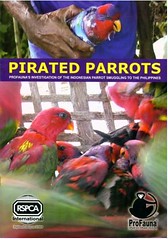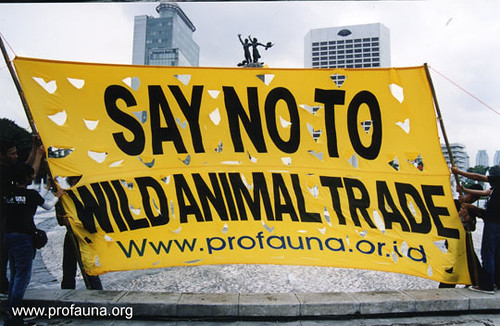tags: smuggling parrots, poaching parrots, ProFauna Indonesia, endangered species, conservation, politics
 You know that I am passionate about the parrots of the south Pacific Ocean -- I devoted my life to researching them, in fact. So it is my responsibility to bring a very important and tragic issue to your attention. Indonesia, home to many of the birds that I love so much, is killing its endemic parrots through poaching and smuggling.
You know that I am passionate about the parrots of the south Pacific Ocean -- I devoted my life to researching them, in fact. So it is my responsibility to bring a very important and tragic issue to your attention. Indonesia, home to many of the birds that I love so much, is killing its endemic parrots through poaching and smuggling.
There are 85 parrot species in Indonesia, 14 of which are globally threatened or endangered. One of the regions with many smuggled parrot species is known as Wallacea -- made famous by Alfred Russel Wallace of evolutionary theory fame -- an island group that includes Sulawesi, Nusa Tenggara, and the Maluku Islands. These islands are home to some of my research birds; the endangered red-and-blue lories, Eos histrio, and black-winged lories, Eos cyanogenia, as well as the yellow-crested cockatoo, Cacatua sulphurea, and the blue-naped parrot, Tanygnathus lucioinensis.

Poaching also occurs on the Indonesian island of Halmahera, which is home to the threatened chattering lories, Lorius garrulous, and the violet-necked lories, Eos squamata, along with the white Cockatoos, Cacatua alba, Eclectus parrots Eclectus roratus. The Eclectus parrot is a protected species which is prohibited for trade. According to the 2008 study, Pirated Parrots [free PDF], 10,000 parrots are annually captured on Halmahera alone.
These wild birds are trapped and transported to open air bird markets in Indonesia, Singapore and the Philippines where the survivors are sold as pets. (40% of all trapped parrots die before reaching the markets).
For example, according to ProFauna Indonesia, an illegal wildlife dealer named Mei Lumombo operates from Halmahera Island, which is north of Maluku. The captured parrots are crammed into small cages and carried across land to the coast where Mei Lumombo then smuggles them to Balut Island or to General Santos in the Philippines, using a private boat. The sea journey to the Philippines occurs once every two weeks and takes at least nine hours.
The hapless parrots are sold to unscrupulous Philippine dealers who meet the Indonesian smugglers' boats while they are still offshore. The surviving birds are then brought to General Santos, and the birds are sent to Cartimar market in Manila, which is the capital of the Philippines.
What can you do to stop this illegal activity? Call, write and email your letters of protest to;
MS Kaban
Menteri Kehutanan
Republik Indonesia Gedung Manggala Wanabhakti Blok I, lantai 4 Jl.
Gatot Subroto, Jakarta Pusat 10270
Phone 021-5731820
Fax 021-5700226
email indofor@dephut.go.id, dirjen.pka@dephut.go.id, and to cites@dephut.go.id.
Jendral Polisi Soetanto
Kepala Polisi
Republik Indonesia MABES POLRI Jl.
Trunojoyo No. 3 Kebayoran Baru Jakarta Selatan
Phone 021-7390306, 3848537
email info@polri.go.id
And carbon copy your letters and other communications to;
R.Tri Prayudhi
Campaign Officer ProFauna Indonesia
ProFauna Headquaters Jl
Raya Candi II no 179 Klaseman, Malang-Indonesia
Phone 0341-570033
Fax 0341-569506
email tri@profauna.org and use this form to communicate with ProFauna.
Include these points in your communications;
- Demand that the Republic of Indonesia government stops parrot smuggling to the Philippines by confiscating the birds from the North Halmahera dealers.
- Demand that the Republic of Indonesia government improve the patrol of marine boundaries between Indonesia and the Philippines especially along the sea route used for wildlife smuggling from Indonesia to the Philippines.
- Urge the Forestry Ministry of Republic of Indonesia to control, investigate, and seize protected wildlife, especially parrots, from traders in the animal markets in Surabaya and Pramuka market in Jakarta.
- Recommend that the Forestry Minister raise the protection status of the White Cockatoo, Cacatua alba. Astonishingly, the white cockatoo is not protected!
Can't speak Indonesian? They have translators available! So be polite, but do it now.
Sources
Pirated Parrots ProFauna, 2008 (free PDF; 9 pages).
Flying Without Wings (fund raising for ProFauna Indonesia).
Help ProFauna Indonesia stop Indonesian parrot smuggling.
166 countries agree to give full protection tothe Yellow-crested Cockatoo.
- Log in to post comments


usually the quickest way to stop something is to legalize it, such as electctus parrot, extremely beautiful and sexes so different looking they were long thought to be 2 different species, and the sulpher crested cockatoo, both are breeding quite well in capitity in the united states, would it be possible to try something like that there, and i know that people are breeding lories here for quite some time i am just not sure of what kind, but maybe you could buy from breeders from the states who are for the most part very responsible here and birds on the cities list have not been allowed to be imported for about approximately the last 30 years, infact the only birds of this type allowed to be imported here have to be certified as pets and have to go through an extended quarintine, i have 2 amazons who were wild caught but legally imported just before they stopped importing them and they are 31 and 32 years old in very good health and still carry the bands that were put on them in quarintine, and still reproduce 1 time a year, that is all i will allow them to do, i don't know if my suggestion has been helpful or not but i hate hearing that these birds are being harmed or killed because of poachers, hope you fix it, maybe you could import some of our burds or pay people to breed them over there strictly controled so they are not just poaching birds and saying they bred them,
Molly, although in some cases legalizing a trade may work to reduce smuggling, it doesn't work with birds. On the contrary, trade bans on wild caught birds have proven to reduce the illegal trade in the US and now also in Europe.
When Indonesia allowed the exports of captive bred parrots, we started to see Cockatoos and Lories imported in Europe with very large leg bands that could be easily removed or applied to adult birds. Those bands were supposed to prove that the birds were bred in captivity, while they were clearly wild caughts.
Illegal shipments of birds have always ben facilitated by the legal trade through the use of forged permits. We have seen this happening often and for birds imported from different parts of the world.
Indonesia is also an avian flu country, from which imports would not be allowed.
The best thing that could be done in the Philippines and in Indonesia is to ban the sale of parrots at markets or enforce the existing laws.
The best way to make a difference is to support the groups that work locally for the conservation of parrots through a variety of programs.
We can also make a difference by not buying products made with uncertified exotic woods, see http://www.greenpeace.org/australia/take-action/live-greener/shopping/g…, as the loss of habitat is also a huge threat for the parrots of Indonesia.
I wonder if the same thing that happens in the Mexican parrot trade happens in the Indonesian parrot trade: Exotic species command a higher price so those who do have the capability to produce captive bred native stock don't because it's not as profitable? Obviously a minor point in the issue, but I'm curious.
Source: http://www.defenders.org/programs_and_policy/international_conservation…
Connie, that's a good question.
Captive breeding would make a lot of sense, reducing the pressures on the wild populations. However, so far it has proven difficult to achieve in almost all of the parrot's range countries, as it's much cheaper and less time consuming to just trap the wild birds.
A slight OT, if you enjoy watching parrots in the wild, the World Parrot Trust has added some great parrot videos on Youtube http://www.youtube.com/user/parrotsdotorg
There are no Lories, but you'll find some great footage of Cockatoos and other parrots.
Thank you, I hadn't thought to look up the WPT on YouTube, the footage of the wild grey parrots is wonderful. The birds look confident and agile. The captive grey is usually ungainly and nervous, even those that free fly at liberty in human environments.
I gave a presentation for my graduate seminar "Predation Physiology" on parrot conservation, I was fed up with academic discussions about poison dart frogs, wolverines and other well-known species that totally ignored their current declines. I tied my presentation in by talking about New Zealand's keas hunting and eating petrels and went from there focusing on how stupid it was to be studying the biology of creatures that were vanishing without even acknowledging there is a problem. A the end of my hour and half everyone was entertained and "gung-ho" about bird conservation, so I pointed out that my professor's outdoor cat was probably taking several hundred birds a year. Bringing his cat inside was a very direct way to support the Central American migrants that nested in his yard. The crux of the matter was his cat would remain outside, and everyone had discussed parrot conservation with adequate beer provided so they could feel good and never think about it again. I'm not terribly satisfied with academia's approach to the current mass extinction/loss of biodiversity even though ecologists and biologists are the ones behind recognizing and dealing with species declines.
I live in the Philippine Republic (Bohol). My wife & I breed budgies and African Lovebirds. There is undoubtably a demand here for larger parrots as pets. I have been trying to locate poential LEGAL breeding stock (Quakers, Conures, Amazons) without success. I will have no dealings with wild caught birds. We breed birds because we enjoy it, not for profit.
My point is, if it is not possible for us to breed the birds people want the pet trade will use wild caught stock.
As a footnote if anyone knows where in the Philippines I can buy the breeding stock I am looking for I would be grateful for the info.